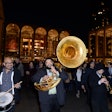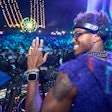
Planners for Casey House's annual SnowBall keep things interesting with decor.
Photo: Gary Beechey for BizBash
“We hear from people during gala season who go to a lot of galas that a lot are boring and formulaic,” says Elaine Bowen, director of development for the Lower Manhattan Cultural Council, which has hosted its annual Downtown Dinner in New York each May for the past four years. She and other planners of annual gatherings know that to ensure guests come back, each year has to be better than the last. So how do they keep their yearly rituals fresh?
Though the cultural council gala follows a typical formula—cocktail reception, dinner, and award ceremony—the event is anything but. Guests have come to expect the unexpected, like guerilla dancers infiltrating the crowd, an M.C. dressed as a clown, and a huge string art installation covering the dining room. “There are always spontaneous things happening,” says Bowen. Celebrity guests are also a draw—this spring, Mayor Michael Bloomberg was an honoree, as were playwright Edward Albee and artist Kiki Smith.New components like auctions or award ceremonies can spice up annual iterations of events. The Casey House, a specialty hospital for people living with HIV and AIDS in Toronto, has been holding its SnowBall, an annual winter fund-raising gala for six years. This year, organizers added the Casey Awards, given in honor of Casey House founder June Callwood, who died last year. The new addition paid off—the event netted $264,000 for its community programs, a total revenue increase of 146 percent from the year prior.
Development manager of events Bill Calkins notes that the event is a success each year due to the efforts of the committee. “We’re careful not to neglect the debrief process, so that we can learn from our successes and also our concerns,” he says. “We’re always fiddling with the recipe, always refining.” Gathering feedback from attendees is a crucial step in starting planning for next year—what hors d’oeuvre they liked, whether or not the speakers prattled on too long, if the video displays were clear at the back of the room.
Decor is a tried-and-true way to keep things interesting—especially when an event is limited in its flexibility by the sheer number of guests, as is the case with the 3,000-person Human Rights Campaign National Dinner, which, for 12 years, has honored the H.R.C.’s most significant allies in Washington, D.C. Senior events manager Camille Rodriguez doesn’t have a lot of location options (the event is held at the Washington Convention Center, one of the only places that can hold such a big group?), so she and her team instead amp up the creativity to keep things novel. “Two years ago we had a 120-foot-long, 30-foot-high video screen,” she says. “It was a huge success and injected new life into the standard stage set.” Last year the length of stage at the front of the room was bordered by 15 sheer panels that changed colors all night, contrasting with the black linens adorning the tables.
Calkins also cites the importance of memorable visuals, like this year’s SnowBall setting adorned with red boa topiary trees à la Dr. Seuss: “We make sure our attendees always walk away marveling at something, with something to talk about with their friends the next day.”
Though the cultural council gala follows a typical formula—cocktail reception, dinner, and award ceremony—the event is anything but. Guests have come to expect the unexpected, like guerilla dancers infiltrating the crowd, an M.C. dressed as a clown, and a huge string art installation covering the dining room. “There are always spontaneous things happening,” says Bowen. Celebrity guests are also a draw—this spring, Mayor Michael Bloomberg was an honoree, as were playwright Edward Albee and artist Kiki Smith.New components like auctions or award ceremonies can spice up annual iterations of events. The Casey House, a specialty hospital for people living with HIV and AIDS in Toronto, has been holding its SnowBall, an annual winter fund-raising gala for six years. This year, organizers added the Casey Awards, given in honor of Casey House founder June Callwood, who died last year. The new addition paid off—the event netted $264,000 for its community programs, a total revenue increase of 146 percent from the year prior.
Development manager of events Bill Calkins notes that the event is a success each year due to the efforts of the committee. “We’re careful not to neglect the debrief process, so that we can learn from our successes and also our concerns,” he says. “We’re always fiddling with the recipe, always refining.” Gathering feedback from attendees is a crucial step in starting planning for next year—what hors d’oeuvre they liked, whether or not the speakers prattled on too long, if the video displays were clear at the back of the room.
Decor is a tried-and-true way to keep things interesting—especially when an event is limited in its flexibility by the sheer number of guests, as is the case with the 3,000-person Human Rights Campaign National Dinner, which, for 12 years, has honored the H.R.C.’s most significant allies in Washington, D.C. Senior events manager Camille Rodriguez doesn’t have a lot of location options (the event is held at the Washington Convention Center, one of the only places that can hold such a big group?), so she and her team instead amp up the creativity to keep things novel. “Two years ago we had a 120-foot-long, 30-foot-high video screen,” she says. “It was a huge success and injected new life into the standard stage set.” Last year the length of stage at the front of the room was bordered by 15 sheer panels that changed colors all night, contrasting with the black linens adorning the tables.
Calkins also cites the importance of memorable visuals, like this year’s SnowBall setting adorned with red boa topiary trees à la Dr. Seuss: “We make sure our attendees always walk away marveling at something, with something to talk about with their friends the next day.”



















